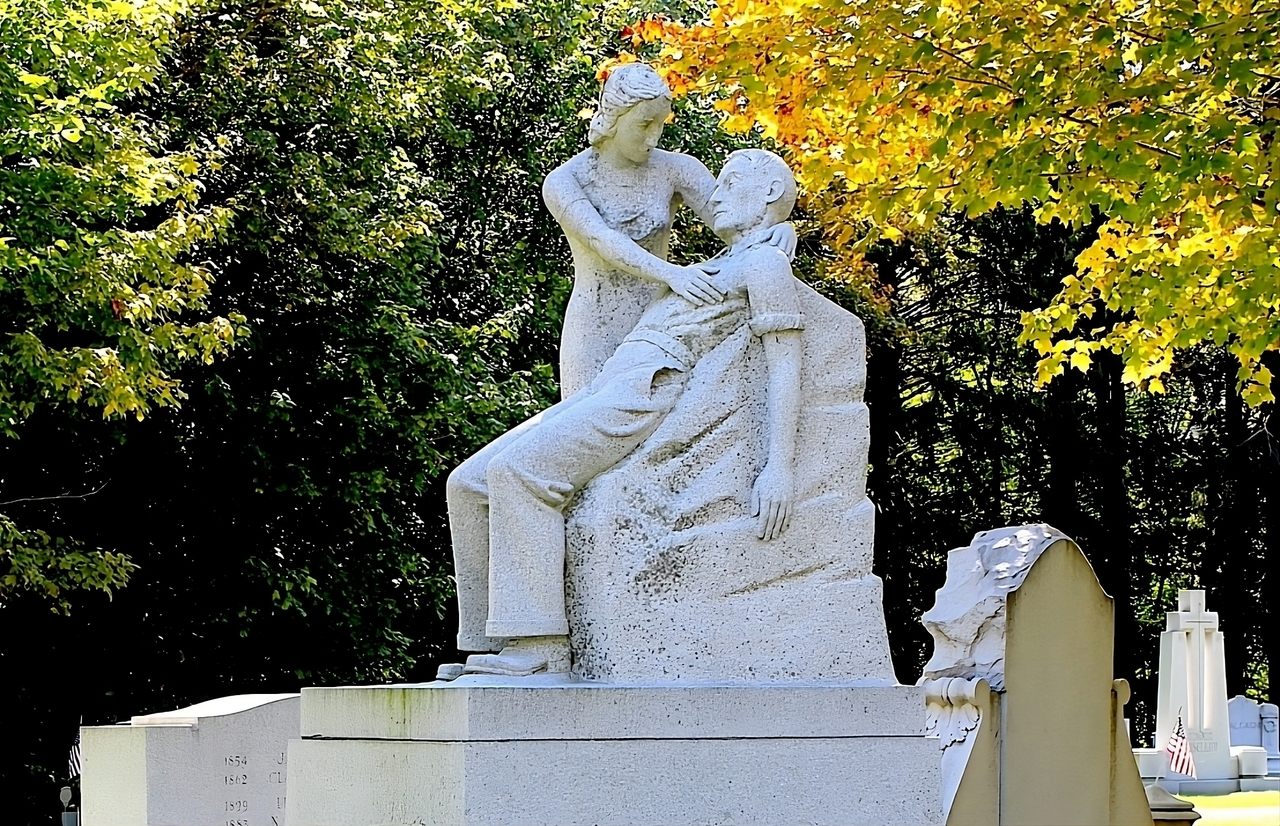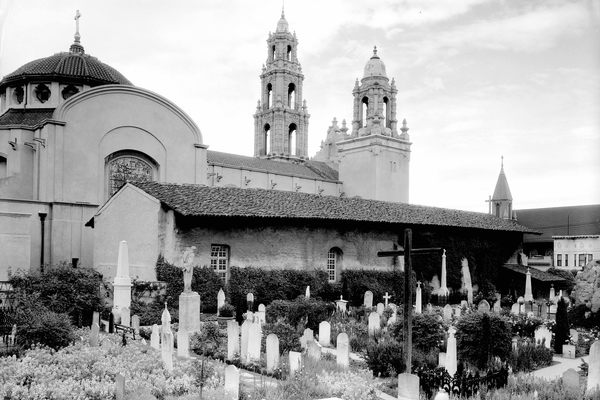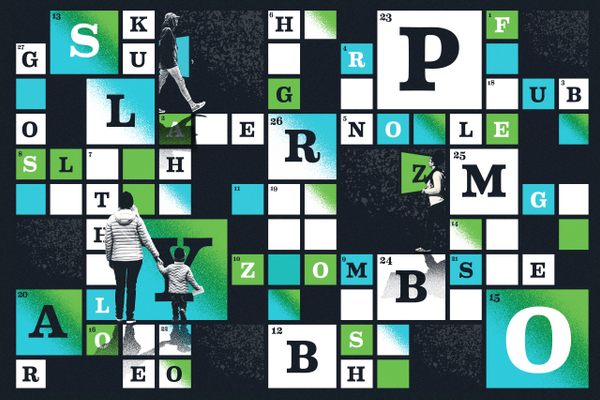The Tombstone Sculptor Who Carved His Own Death in Granite
Nestled in Vermont’s Hope Cemetery, ‘The Dying Man’ tells the tragic tale of the area’s Italian gravestone carvers.
It’s almost over. For years, Luigi “Louis” Giovanni Brusa has struggled for air and battled a persistent cough. In his final moments, he crumples back into a seat of rough stone. His arms limp at his side, a devoted woman to his right looks at him with affectionate concern, and perhaps a bit of surrender, rubbing his chest. It’s a touching scene—carved entirely from gray granite.
It feels almost like an imposition to cast eyes on this vulnerable moment captured in stone. But that’s how Brusa wanted it. The master granite carver in northern Barre, Vermont, just 45 miles southeast of Burlington, enlisted one of his most talented peers, Donato “Don” Coletti, to hand carve his gravestone.
The finished monument shows Brusa’s final moments as he struggles for breath after years of inhaling granite dust. With the tombstone already completed, this exact scene played out in 1937 when the brilliant granite artisan passed away of silicosis.
Today, the harrowing memorial stands in a solemn corner of Hope Cemetery, a 65-acre plot of land filled with memorials to the craftspeople who carved out Barre’s reputation as the “Granite Capital of the World.”

According to Scott McLaughlin, executive director of the Vermont Granite Museum in Barre, Brusa was born in October 1886 to a stonecutter family in the Lombardia province of northern Italy. It could be said that from then on his fate was sealed.
51 years later, Brusa died of silicosis, the same year that the Vermont legislature passed laws that would improve conditions for granite workers. Silicosis is a lung disease that’s common among stone workers, miners, and others who might inhale silica—a mineral found in many types of rock. It became more of a hazard after compressed-air tools were invented in the late 19th century, kicking up far more dust than a hammer and chisel ever could.
According to Denver-based pulmonologist and silicosis expert Stephen Newman, the range of symptoms that can erupt from the disease is staggering. “It’s not just shortness of breath. They can develop tuberculosis,” says Newman. “They can develop cancer of the lungs related to silicosis.” He even says that the substances in the dust patients inhale can activate autoimmune joint diseases, such as lupus or rheumatoid arthritis.
For generations, silicosis felled the granite workers of Barre, where Brusa and his brothers settled and started a business, Brusa Brothers Manufacturers. The eldest, Cesare Brusa, lost his battle with silicosis in 1927 at age 43. He and the Brusas’ parents, stone carver Ernesto Brusa and wife Maria, are buried beneath a memorial in Hope Cemetery that Luigi Brusa carved.
The monument is known as “The Bored Angel.” It depicts a winged female figure cradling her chin in a resigned position. Over one leg, she drapes a trumpet ready to signal the second coming of Christ. But the angel has put it aside. She seems to know that the dead will not be raised incorruptible anytime soon.

This history of Italian artisans in Barre dates back to the 1890s. Northern Italians were attracted to the area’s Rock of Ages Granite Quarry, which opened in 1885 and is still operational and open to visits from the public. It didn’t hurt that the mountainous topography and Lake Champlain were a suitable stand-in for their homeland.
What they might not have expected were the enclosed spaces they would be working in the cold months, unlike the open-sided granite sheds back in more temperate Italy. But even after Brusa’s death, more Italian stone carvers continued to immigrate to the region.
Giuliano Cecchinelli, a native of the Italian marble capital, Carrara, came to Barre in 1965. His father, also a granite carver, helped get him a job at Buttura & Sons, creating monuments. The younger Cecchinelli still works there, though it’s now known as Buttura & Gherardi Granite Artisans. In fact, Cecchinelli claims that his family goes back more than 20 generations in the craft.
But an artistic eye isn’t all Cecchinelli inherited. Despite the improved ventilation that granite sheds were forced to adopt over the years, he has not sidestepped silicosis.
“I’ve been at it for so long, it’s a privilege to have it,” says Cecchinelli. “To me, I’m a blessed person. No silica can get me. People died of silica when they were 30, 40, 50 years old. Here I am at 80.”
Not surprisingly, Cecchinelli has a special affinity for the Brusa monument. He believes that Colletti may have copied a pre-existing stone monument from Milan’s Cimitero Monumentale, one of the planet’s foremost displays of sculpture.
Specifically, Cecchinelli thinks artist Emilio Quadrelli’s “Last Kiss” memorial in Monumentale may have served as the archetype for Luigi Brusa’s own tombstone. But it’s clear upon closer inspection that Last Kiss is more inspiration than model.

McLaughlin says that it’s only natural that the European-trained Italian artisans would emulate the style found in cemeteries, like Monumentale. He adds that Luigi Brusa’s gravestone, known as “The Dying Man,” was an original work that went a step beyond a typical memorial to one individual. The Dying Man was both a warning and a memorial to a community of craftspeople.
“The intention was as a word of caution to those working in the industry. It’s supposed to be sort of a reflection on the sacrifices this community has gone through,” says McLaughlin.
Despite the somber feel of the memorial, it’s managed to generate some winking gossip. Most accounts say the woman depicted in the gravestone is Brusa’s wife, Mary. But according to urban legend, when the stone was revealed, there were whispers that, while the man indeed resembled Brusa, the woman bore more of a similarity to his mistress than to Mary.
But the controversy does little to dim the impact of the artwork. Coletti himself was buried at Hope Cemetery after his death at the age of 53, officially due to cardiac issues, though his obituary noted that he had been in poor health for at least a year.
Today, Coletti’s monument for his friend stands as a quiet testament to Brusa’s struggle with the disease, and to all who are affected by it. As long as it stands, Brusa and his peers will never be forgotten.














Follow us on Twitter to get the latest on the world's hidden wonders.
Like us on Facebook to get the latest on the world's hidden wonders.
Follow us on Twitter Like us on Facebook